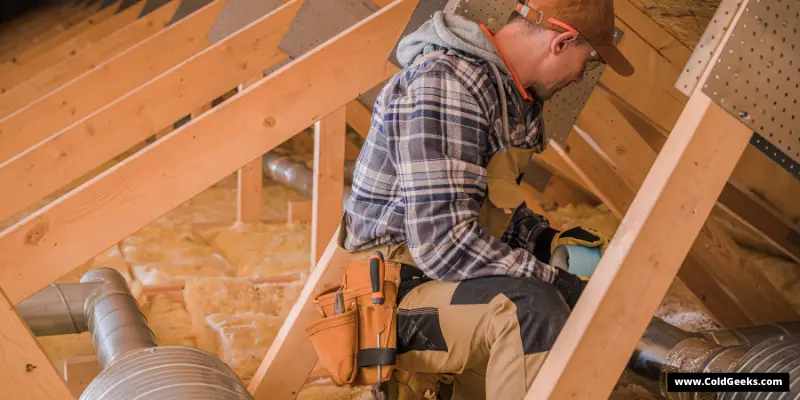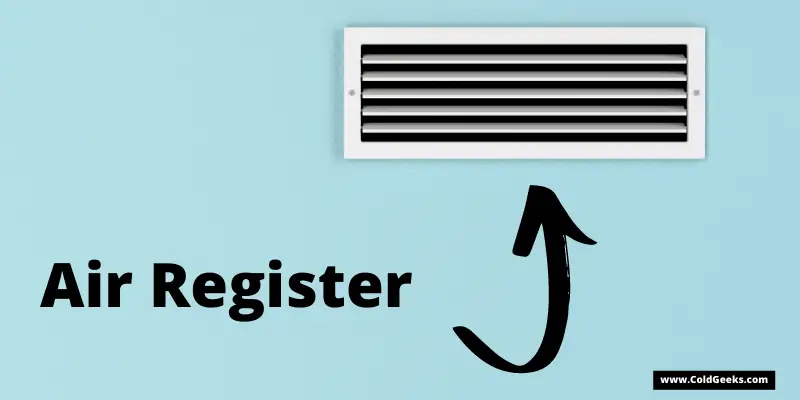If a room in your house is always freezing or lava-hot, you may need a booster fan.
What is a booster fan?
A booster fan is an electric fan that is used to increase the airflow in a room or space. They take air from ductwork and distribute it throughout the house. Booster fans are often used in conjunction with other fans, such as an attic fan, bathroom vent fan, or whole-house fan.
There is a lot more to booster fans, like knowing what they do and don’t do, where they go, and what type you might need.
What Do Booster Fans Do?

Booster fans quite simply “boost” airflow.
They work by drawing in air from one area and blowing it out to another. Hot and cold air gets trapped in ductwork, so HVAC booster fans propel that trapped air into rooms far away from heating and cooling systems.
This increased airflow can help to improve comfort levels, heating, and cooling in a room.
Dryer booster fans help to improve air circulation and drying times for clothes.
What Booster Fans Don’t Do
Booster fans don’t actively cool or heat a room. They just circulate the air that’s already in there.
If you’re looking for a whole-house cooling system, booster fans play just one part.
You’ll need an AC unit, along with as many other fans as you prefer (tower fans, pedestal fans, ceiling fans, attic fans, blower fans, etc).
Who Needs a Booster Fan?
Not everyone needs a duct booster fan.
However, there are certain times when an inline booster fan is exactly what you need to solve heating and cooling issues in your house.
For example, if a second-floor room often gets really stuffy or cold. Or, if you have a room on the other side of your house that never seems to get cool enough in the summer months.
Booster fans are often used with air conditioning units to make sure all parts of a home are adequately cooled.
They’re also great for heating systems, which distribute heat unevenly through the ductwork throughout a larger house or building.
Where Should a Booster Fan Be Placed?
Generally, you place a duct booster fan in the midpoint between your fan/blower and the room you want to cool or heat.
For example, if you have a whole-house fan and need some extra airflow in your bedroom, place the booster fan in the ductwork between the vent in your bedroom and the whole-house fan.
If your heating system isn’t reaching certain rooms enough during winter, put it midway between the vent and the room.
Another option is to place your booster fan approximately 6-10 feet from the vent in the room you want to cool or heat.
Types of Booster Fans
There are many types of booster fans. The most common type is the inline duct booster fan.
Booster fan types include:
- Duct booster fan
- Inline booster fan
- Rectangular duct booster fan
- Heat duct booster fan
- Furnace booster fan
- Floor duct booster fan
- Doorway booster fan
- Dryer booster fan
- Register booster fan
- Battery-powered vent booster fan
- Duct booster fan with pressure switch (automatic booster fan)
What Is a Duct Booster Fan?
A duct booster fan is a standard booster fan with a different name. Duct booster fans are installed in the ductwork of a residential house or other building.
There are two main types of duct booster fans:
- Inline booster fan
- Rectangular duct booster fan
What Is an Inline Booster Fan?
An inline booster fan is installed in the ductwork between two points.
This type of booster fan is used in duct systems with round ductwork.
Most ductwork is round, so that’s why an inline booster fan is the most common type of duct booster fan.
What Is a Rectangular Duct Booster Fan?
A rectangular duct booster fan is installed in the joint between two pieces of ductwork.
Typically, you slide the rectangular duct booster fan into the joint, securing it with self-tapping screws. I suggest sheet metal screws.
You might also come across rectangular booster fans inside metal sleeves that are made for fiberglass ductwork.
You may need custom clips to keep sleeved booster fans in place.
Where do you find rectangular ductwork?
Rectangular ductwork is usually located in overhead gaps between floor joists.
Sometimes, they are also used in attics.
I’m not a huge fan of the rectangular shape because it leaves too many pressure gaps that hamper the HVAC system and often increase your heating and cooling costs.
What Is a Heat Duct Booster Fan?
A heat duct booster fan is a type of duct booster fan that helps to evenly distribute heat in a home or other building.
This type of fan is usually installed in the middle of the ductwork run.
What Is a Furnace Booster Fan?
A furnace booster fan is a type of duct booster fan that helps to move heated air from the furnace to different parts of the home.
This type of fan is usually installed in or near the furnace.
What Is a Floor Duct Booster Fan?
A floor duct booster fan is a type of duct booster fan that helps to move heated or cooled air from the floor to different parts of the home.
This type of fan is usually installed in the ductwork under the floor and/or in the basement.
What Is a Doorway Booster Fan?
A doorway booster fan is a very small fan that you install in the top corner of a doorway.
One side of the fan is round. The other side of the fan is “L” shaped to fit into the groove of the doorframe.
Typically, you secure a doorway booster fan with screws and a metal base.
Doorway booster fans increase airflow between rooms and can help to cool one room by using the air from another room.
What Is a Dryer Booster Fan?
A dryer booster fan helps to move heated air through long dryer vents.
Personally, I’d recommend a dryer booster fan if your dryer duct is longer than 25-30 feet.
The shorter your dryer duct, usually the better.
However, that’s not always possible. A dryer booster fan will push heat inside of your ductwork into the dryer.
The result is a better performing dryer and faster drying of your clothes.
What Is a Register Booster Fan?
A register booster fan is a compact electric fan that pushes air through long ductwork. Simply connect it to your HVAC system and place it into the air register.
An air register is an adjustable metal grill that covers vents in your house or building.

The register booster fan turns on whenever your HVAC system is running.
Unlike traditional booster fans that you install in midway points, an air register booster fan is designed for placement directly inside the vent (behind the metal grill).
A register booster fan is also known as a vent booster fan.
What Is a Battery-Powered Vent Booster Fan?
A battery-powered vent booster fan is run by batteries. They require routinely changing out the batteries in the fan.
However, they can be a great failsafe in a power outage.
If your HVAC system isn’t running, the battery-powered vent booster fan will still help to push air through the ducts and vents in your home.
What Is a Duct Booster Fan With Pressure Switch?
A duct booster fan with a pressure switch is a type of booster fan that turns on and off automatically.
The pressure switch activates the booster fan when it detects adequate air pressure from a running HVAC system.
The pressure switch comes with a timer with standard ON and OFF cycles.
This allows the booster fan to restart automatically as long as the switch continues to sense enough pressure.
Automatic booster fans are pretty cool.
Check out this video demonstration of installing an automatic booster fan into a duct system:
Best Booster Fans
The best booster fan is the one that meets your specific needs without breaking the bank. You also don’t want something cheap that you’ll have to replace every year.
Keeping these factors in mind, here are my personal recommendations for the best booster fans:
| Use/Need | Best Booster Fan |
|---|---|
| Best overall | TerraBloom 6 Inch (150mm) Inline Fan |
| Budget-Friendly | AC Infinity RAXIAL S4, 4” with Speed Controller |
| Quietest | TerraBloom ECMF-100, Quiet 4 Inch |
| Air register (vent) fan | Tjernlund RB10W |
| Dryer Booster Fan | Spruce Automatic Clothes Dryer |
Final Thoughts: What Is a Booster Fan?
Before purchasing a booster fan, be sure to get your entire heating and cooling system checked by a professional. Blower fans will not solve more serious issues with an HVAC system.
Even if there’s nothing wrong with your system, it’s always better to know for sure.
Learn about other fan types:
- What Is a Blower Fan? (Explained for Beginners)
- What Is a Dual Mount Ceiling Fan? (Explained W/ Pictures)
- What Is a Neck Fan? (Explained for Beginners)
- What Is a Drum Fan? (Explained for Beginners)
